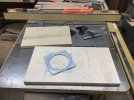TasTinker
Member
- Joined
- Aug 5, 2023
- Messages
- 14
- Likes
- 49
With discussion in various development threads on DIY spin turntables I'm picking up on Rick Sykoras suggestion and starting a thread for DIY turntable build ideas.
Most use one of the various furniture dolly offerings. Here's a different approach I took using a bolt on front wheel bearing assembly from a car. Obviously not for everyone but has the advantage of greater overhang strength, especially when doing vertical spins with floostanders hanging out to one side.



Most use one of the various furniture dolly offerings. Here's a different approach I took using a bolt on front wheel bearing assembly from a car. Obviously not for everyone but has the advantage of greater overhang strength, especially when doing vertical spins with floostanders hanging out to one side.



